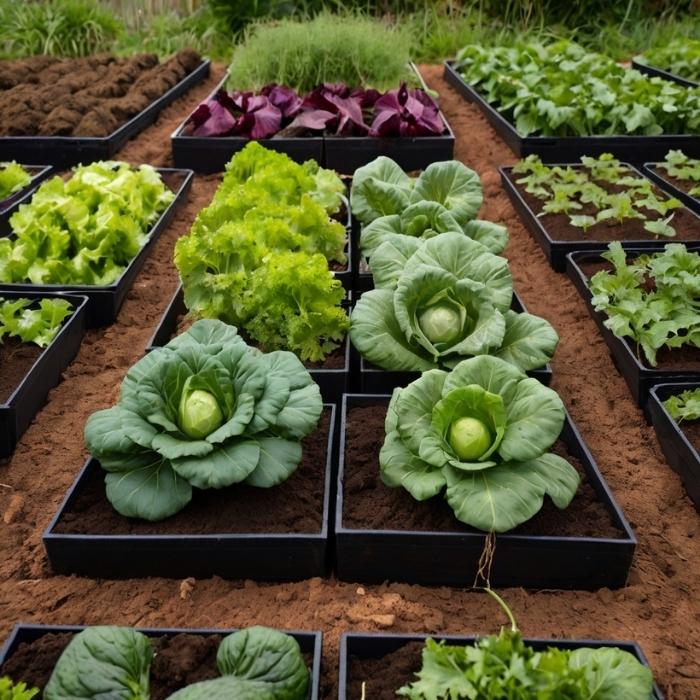Seasonal Vegetable Layouts: A Comprehensive Guide
Creating a thriving vegetable garden requires more than just planting seeds; it involves thoughtful planning, especially when it comes to seasonal layouts. Understanding how to arrange your vegetables according to the seasons can significantly enhance your garden’s productivity, health, and overall success. In this guide, we will delve into the importance of seasonal vegetable layouts, explore various layout strategies, and provide actionable tips for maximizing your garden’s potential throughout the year.
The Importance of Seasonal Planning
Gardening is inherently tied to the seasons, with different crops thriving at different times of the year. By understanding these seasonal patterns, you can create a layout that optimizes growth and yield. Here are the primary growing seasons:
Cool Season
The cool season typically spans early spring and fall. During this time, temperatures are mild, making it ideal for growing leafy greens and root vegetables. Some popular cool-season crops include:
- Lettuce: Quick to germinate and harvest, lettuce thrives in cooler temperatures.
- Spinach: A nutrient-dense green that can be sown early in spring or late in summer.
- Broccoli: A versatile vegetable that prefers cooler weather for optimal growth.
- Carrots: These root vegetables do well in cooler soil conditions.
Warm Season
The warm season extends from late spring through early fall, characterized by higher temperatures. This is when heat-loving plants such as tomatoes, peppers, cucumbers, and squash flourish. Key crops include:
- Tomatoes: A staple in many gardens, tomatoes require full sun and warmth.
- Cucumbers: Fast-growing vines that thrive in warm weather.
- Peppers: Both sweet and hot varieties flourish in the heat.
- Beans: These legumes not only produce delicious pods but also enrich the soil with nitrogen.
Cold Season
Even during winter months, certain hardy vegetables can be grown with protective measures. Cold-season crops include:
- Kale: Extremely resilient and can withstand frost.
- Leeks: These can be planted in late summer for a winter harvest.
- Brussels Sprouts: They actually taste sweeter after exposure to frost.
By aligning your garden layout with these seasonal cycles, you can ensure a continuous supply of fresh produce throughout the year.
Popular Vegetable Garden Layouts
1. Square Foot Gardening
Square foot gardening is an efficient layout method that divides your garden into small squares (typically 4×4 feet). Each square is dedicated to a different crop based on its space requirements. This method offers several advantages:
- Crop Rotation: Each season allows for rotation of crops to prevent soil depletion and manage pests effectively.
- Maximized Yield: Intensive planting within each square can lead to higher yields in smaller spaces.
For example, you might plant one square with lettuce (16 plants), another with carrots (16 plants), and yet another with tomatoes (1 plant). This method not only maximizes space but also makes it easier to manage different crops.
2. Row Planting
Row planting is one of the most traditional methods where vegetables are planted in long, straight rows. This approach is straightforward and allows for easy access during maintenance and harvesting. Here are some key considerations:
- Orientation: Rows should ideally be oriented north-south to ensure optimal sunlight exposure throughout the day.
- Height Arrangement: Taller plants should be placed on the north side of each row to prevent shading shorter plants.
Row planting works well for larger gardens where you have enough space to walk between rows for weeding and harvesting.
3. Block Planting
Block planting involves grouping similar crops together in rectangular blocks rather than rows. This layout supports companion planting—growing plants that benefit each other—enhancing both aesthetics and productivity. Benefits include:
- Efficient Use of Space: Blocks can be tailored to fit specific garden dimensions without rigid spacing constraints.
- Easier Crop Rotation: Similar to square foot gardening, block planting facilitates effective crop rotation practices.
For example, you might plant a block of peppers adjacent to a block of basil, which can help deter pests while enhancing flavor.
4. Intercropping
Intercropping is an innovative strategy where fast-growing crops are planted alongside slower-growing ones. For instance, radishes can be sown between rows of tomatoes. This method allows for:
- Maximized Harvests: By utilizing vertical space and time efficiently, gardeners can enjoy multiple harvests within the same area.
- Diverse Plant Health: Different root structures and nutrient needs can enhance soil health while reducing pest issues.
Intercropping not only increases productivity but also creates a more resilient garden ecosystem.
Planning for Year-Round Harvests
To extend your growing season beyond traditional limits, consider implementing season extenders such as:
Cold Frames
Cold frames are simple structures that trap heat from sunlight, allowing for early spring planting or late fall harvesting of cold-hardy crops. They provide protection from frost while allowing sunlight to penetrate.
Mini Hoop Tunnels
Mini hoop tunnels act like mini greenhouses and provide protection from frost while promoting faster growth of warm-season vegetables. They are easy to set up using PVC pipes or flexible wire covered with plastic sheeting.
Deep Mulching
Deep mulching involves applying a thick layer of organic material (like straw or wood chips) around plants to insulate soil during winter months. This technique helps retain moisture and regulate soil temperature, allowing root vegetables to be harvested throughout the cold season.
Companion Planting Strategies
Companion planting enhances both aesthetic appeal and productivity in your vegetable garden. Consider these beneficial pairings:
Tall Plants with Climbing Varieties
Pairing tall plants like sunflowers with climbing beans not only creates an attractive display but also provides support for the beans while attracting beneficial insects that pollinate both plants.
Diverse Textures and Colors
Mixing various plant types adds visual interest while promoting biodiversity that can deter pests naturally. For instance, planting marigolds alongside vegetables can repel nematodes and other harmful insects.
Conclusion
Designing a seasonal vegetable layout requires an understanding of plant needs and seasonal cycles. By employing methods such as square foot gardening, row planting, block planting, intercropping, and companion planting, gardeners can maximize their yields while maintaining healthy soil. Additionally, using season extenders allows for year-round gardening opportunities.With careful planning and creativity, anyone can cultivate a productive vegetable garden that thrives through every season. Whether you’re a novice gardener or an experienced horticulturist, embracing Seasonal vegetable layouts will help ensure your gardening success while providing fresh produce for you and your family all year long! Vegetables to Grow in Pots for a Thriving Container Garden

